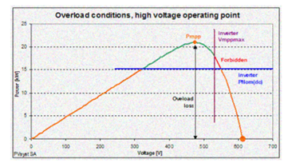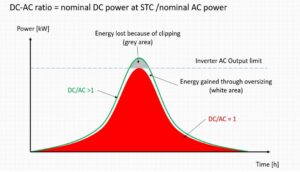Image: About electric
Written by Vaggelis Ioannou, electrical engineer at Wattcrop.
What is DC/AC ratio
The DC/AC ratio of a Solar Plant is considered as the installed DC Power of the PV modules relative to the AC Power of the inverters that the modules are connected to. The last years, this ratio is increasing due to the falling prices of the PV Panels and inverter’s improved techniques utilizing the available grid capacity.
Solar Plant Dimensioning
The DC peak power of the PV module mentioned to the datasheet (STC) isn’t usually met in real conditions. To be more specific, the STC conditions are referring to 1000W/m2 radiation with 25οC cell temperature, which means 0οC ambient temperature. Therefore, the output power of the module is increasing when higher radiation with lower temperature conditions are met. This is also the reason why Meteorological Data of the Site is vital information for the designer.
Considering the above, the designers undersize the inverter AC Power in comparison with the PV module DC power in order to accommodate this difference. The Optimal ratio will optimize the Project.
Why and how do inverters clip?
 Every inverter has a maximum rated power which they will never overpass. Therefore, during times when the DC produced power gets higher than the inverter’s rated AC Power, the inverter will raise the operating voltage of the module array to pull it out of its maximum power point and reduce the DC Power. The power loss in this case is Pmpp-Pnom,dc.
Every inverter has a maximum rated power which they will never overpass. Therefore, during times when the DC produced power gets higher than the inverter’s rated AC Power, the inverter will raise the operating voltage of the module array to pull it out of its maximum power point and reduce the DC Power. The power loss in this case is Pmpp-Pnom,dc.
 In case the voltage of this Pnom,dc operating point is greater than the inverter’s Vmpp,max voltage, there will be no possible operating point with both conditions met (Pnom,dc and Vmpp,max). Thus, the inverter will have to stop in this case.
In case the voltage of this Pnom,dc operating point is greater than the inverter’s Vmpp,max voltage, there will be no possible operating point with both conditions met (Pnom,dc and Vmpp,max). Thus, the inverter will have to stop in this case.
In such situation, the solution is either to reduce the DC/AC ratio or to design the Project introducing Battery Energy Storage System (BESS), especially when grid limits/curtailments are applied.
Clipping Losses
When the PV Modules Power is higher than the inverter’s maximum AC output power, the inverter us clipping the Pmpp-Pnom,dc power, called clipping losses. Clipping losses occur on the sunniest days of the year and typically during summer months. Considering the degradation of the PV modules, the clipping losses are higher when the systems start and will decrease over time.
There are two (2) parameters here that are relative to the DC/AC ratio:
- increasing the DC/AC ratio will result to clipping losses
- increasing the DC/AC ratio results to higher DC rating so any time the inverter is functioning is producing more energy than it would have with lower DC/AC ratio.
 Therefore, as depicted to the picture below, the designer has to balance between the above parameters (between clipping losses and excess energy generated outside the clipping window) and determine what is the most beneficial scenario for the customer.
Therefore, as depicted to the picture below, the designer has to balance between the above parameters (between clipping losses and excess energy generated outside the clipping window) and determine what is the most beneficial scenario for the customer.
Also, by this way the PV power curve is flattened to approach the Load demand curve and help the integration of more Solar Plants to the Grid.
Recommended DC/AC ratio
In general, the optimal DC/AC ratio may differ based on the Meteorological data of the Site. According to the United States Energy Information Administration (EIA) an increasement of the ratio is noticed the last years, as shown below:
 The parameters for granting the optimal ratio for a specific application can be considered as:
The parameters for granting the optimal ratio for a specific application can be considered as:
- Meteorological Data of the Site
- Topography of the Site
- Clipping losses
- Energy gained through oversize
- Grid Curtailments or limits
- Chosen equipment specifications
- Financial parameters
For a Site in Greece, assuming no grid limitations the clipping losses due to higher DC/AC ratio (considering the energy gained through oversize) are depicted below:
| DC/AC Ratio | 1 | 1.1 | 1.19 | 1.3 | 1.4 |
| Clipping Losses | 0.00% | 0.01% | 0.19% | 0.82% | 1.61% |

